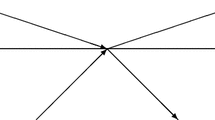Abstract
The most efficient way of obtaining information about the state of a quantum system is not always a direct measurement. It is sometimes preferable to extend the original Hilbert space of states into a larger space, and then to perform a quantum measurement in the enlarged space. Such an extension is always possible, by virtue of Neumark's theorem. The physical interpretation usually given to that theorem is the introduction of an auxiliary quantum system, prepared in a standard state, and the execution of a quantum measurement on both systems together. However, this widespread interpretation is unacceptable, because the statistical properties of the supposedly standard auxiliary system are inseparably entangled with those of the original, unknown system. A different method of preparing the auxiliary system is proposed, and shown to be physically acceptable.
Similar content being viewed by others
References
J. von Neumann,Mathematical Foundations of Quantum Mechanics (Princeton University Press, Princeton, 1955); translation ofMathematische Grundlagen der Quantenmechanik (Springer, Berlin, 1932).
J. S. Bell,Rev. Mod. Phys. 38, 447 (1966).
J. S. Bell,Physics 1, 195 (1964).
N. D. Mermin,Physics Today 38(4), 38 (1985).
A. Peres and S. J. Feingold,Physics Today 38(11), 15 (1985).
W. Heisenberg,Z. Phys. 43, 172 (1927).
J. A. Wheeler and W. H. Zurek,Quantum Theory and Measurement (Princeton University Press, Princeton, 1983).
A Peres,Found. Phys. 14, 1131 (1984).
I. R. Senitzky,Phys. Rev. Lett. 47, 1503 (1981).
S. L. Meyer,Data Analysis for Scientists and Engineers (Wiley, New York, 1975), pp. 131–136.
E. B. Davies and J. T. Lewis,Commun. Math. Phys. 17, 239 (1970).
P. A. Benioff,J. Math. Phys. 13, 231, 908, 1347 (1972).
C. W. Helstrom,Quantum Detection and Estimation Theory (Academic Press, New York, 1976), pp. 74–83.
A. S. Holevo,Probabilistic and Statistical Aspects of Quantum Theory (North-Holland, Amsterdam, 1982), pp. 64–68.
A. S. Holevo,Probl. Inf. Transm. 9, 110 (1973).
E. B. Davies,IEEE Trans. Inf. Theory IT-24, 596 (1978).
C. Shannon,Bell Syst. Tech. J. 27, 379, 623 (1948).
L. B. Levitin, inInformation Complexity and Control in Quantum Physics, A. Blaquière, S. Diner, and G. Lochak, eds. (Springer, Vienna, 1987), pp. 15–47.
J. L. Park,Found. Phys. 1, 23 (1970).
M. A. Neumark,Izv. Akad. Nauk SSSR, Ser. Mat. 4, 53, 277 (1940);C. R. (Doklady) Acad. Sci. URSS (N.S.) 41, 359 (1943).
N. I. Akhiezer and I. M. Glazman,Theory of Linear Operators in Hilbert Space (Ungar, New York, 1963), Vol. 2, pp. 121–126.
Author information
Authors and Affiliations
Additional information
Dedicated to John S. Bell, whose profound insight helped us to overcome deeply ingrained prejudices.
Rights and permissions
About this article
Cite this article
Peres, A. Neumark's theorem and quantum inseparability. Found Phys 20, 1441–1453 (1990). https://doi.org/10.1007/BF01883517
Received:
Issue Date:
DOI: https://doi.org/10.1007/BF01883517



